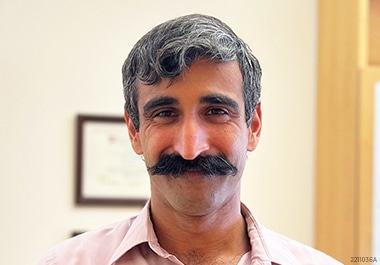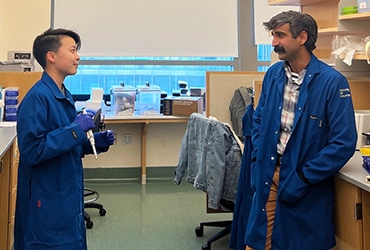From the AACR Annual Meeting to a Therapeutic Strategy for Rhabdomyosarcoma
By Christina Leah B. Kline, PhD

Rhabdomyosarcoma (RMS) is the most common soft-tissue sarcoma in children and young adults with most of the patients being under 10 years old. FOXO1 fusion status has been shown to be the most significant factor affecting outcomes among patients who have localized disease with an overall survival (OS) rate of 65% versus 88% for FOXO1 fusion positive (FP) and FOXO1 fusion negative patients (FN), respectively (1). The research team led by Amit J. Sabnis, MD, demonstrated the dependence of FP RMS on mTORC1 activity and the therapeutic potential of bi-steric mTORC1 inhibitors in this disease setting. Dr. Sabnis highlights, “by refining a target population and identifying a specific mTORC1 activity required for cancer cell viability, we provided two important ways to guide clinical development of mTOR inhibition in rhabdomyosarcoma going forward.”
Dr. Sabnis, an assistant professor at the University of California, San Francisco, received the AACR-Aflac, Inc. Career Development Award for Pediatric Cancer Research in 2017. The grant helped support his efforts to develop therapies for an aggressive subset of FP RMS patients – those that harbor a PAX3-FOXO1 fusion. His preliminary results using a CRISPRi platform pointed to a putative and novel synthetic lethal interaction between PAX3-FOXO1 and GATOR2 (a nutrient-responsive activator of mTORC1). Thus, he set out to identify the consequences of GATOR2 loss in multiple RMS models.
Prior to Dr. Sabnis’ findings, GATOR2’s role in sarcoma had not been elucidated. GATOR2 facilitates the recruitment of mTORC1 to the lysosomal membrane in response to amino acid levels. Dr. Sabnis and his colleagues confirmed that knocking down GATOR2 in an FP RMS cell line, Rh30, reduced the localization of mTOR to the lysosome and mTORC1 activation (as indicated by phosphorylation of the mTOR substrate p70S6K) in response to amino acid level perturbations. Similar to what is observed with pharmacological inhibition of mTORC1, GATOR2 knockdown in two FP RMS cell lines slowed G1-S cell cycle progression.

GATOR2’s impact on mTORC1 is dependent on its ability to bind to GATOR1. GATOR2 is a complex of 5 proteins (MIOS, WDR59, WDR24, SEH1L and SEC13) with each protein having mTORC1-dependent and mTORC1-independent roles. Dual knockdown of the critical GATOR1 component DEPDC5 and MIOS or WRD59 and thereby, enabling mTORC1 activation, relieved FP RMS cells’ dependence on GATOR2.
Given the critical role of mTORC1 signaling in FP RMS cell growth, the research group explored the efficacy of mTOR inhibitors in FP RMS. Although the allosteric mTOR inhibitor temsirolimus had been shown to improve event-free survival in RMS patients with relapsed disease, it was not curative (3). In glioma, bi-steric mTOR inhibitors can suppress a broader number of mTORC1 outputs more durably than allosteric inhibitors. Thus, in this study, RMC-6272, a preclinical tool compound with properties representative of the clinical stage bi-steric mTORC1 inhibitor RMC-5552 (currently in phase 1 testing) was tested. RMC-6272 effectively inhibited the growth of FP RMS cells in vitro and FP RMS patient-derived xenografts in vivo.
The idea to test 3rd generation mTOR inhibitors for FP RMS can be traced back to AACR. As Dr. Sabnis shared, “The recommendation came from a Q&A session at a Pediatric Cancer Working Group symposium at the AACR Annual Meeting a few years ago! Both the financial support of the AACR-Aflac Career Development Award and the opportunity to share my work at AACR-sponsored meetings were instrumental to helping me get the full project across the finish line as the first product of my independent research career.”
References:
- Hibbitts E, Chi Y-Y, Hawkins DS, Barr FG, Bradley JA, Dasgupta R, et al. Cancer Med 2019;. 8: 6437-6448
- Bar-Peled L, Chantranupong L, Cherniak AD, Chen WW, Ottina KA, Grabiner BC, et al. Science 2013; 340:1100-1106
- Mascarenhas L, Chi Y-Y, Hingorani P, Anderson JR, Lyden ER, Rodeberg DA, Indelicato DJ, et al. J Clin Oncol 2019; 37: 2866-74